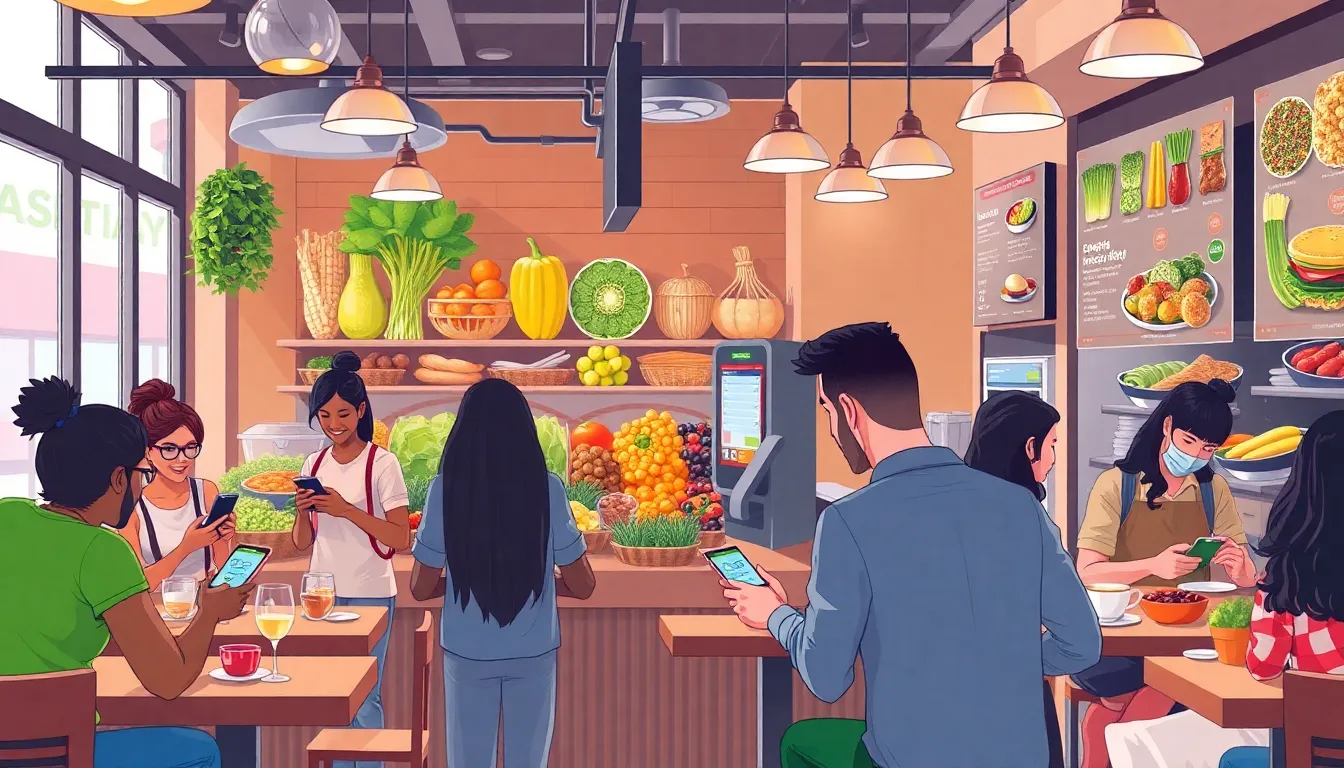In a world where avocado toast reigns supreme and plant-based burgers are the new rock stars, the foodservice industry is buzzing with excitement. Trends are shifting faster than a chef can say “bon appétit,” and staying ahead of the curve is crucial for anyone in the game. Whether you’re a seasoned restaurateur or a curious foodie, understanding these trends can be the secret ingredient to success.
Foodservice Industry Trends
The foodservice industry continues evolving, with several significant trends shaping its landscape. Plant-based options are gaining traction, as consumers increasingly prioritize health and sustainability. Restaurants are adapting their menus to feature these alternatives, reflecting a broader shift toward vegetarian and vegan diets.
Delivery and takeout services have surged, driven by consumer demand for convenience. Businesses are enhancing their online ordering systems, as seamless experiences become vital for attracting customers. Additionally, investments in delivery partnerships are prevalent as eateries seek expanded market reach.
Health-conscious dining options are also on the rise. Consumers prefer meals that are not only flavorful but also nutritious. Many establishments are incorporating superfoods, organic ingredients, and allergen-friendly alternatives to cater to diverse dietary needs.
Another trend involves the use of technology in foodservice operations. Many restaurants now employ automation for tasks such as inventory management and customer service. This tech integration can streamline processes, reduce labor costs, and elevate the overall dining experience.
Sustainability initiatives are becoming a focal point for many establishments. Efforts to reduce food waste and source local ingredients align with consumer expectations for responsible dining. Growing awareness surrounding environmental impact has led restaurants to implement eco-friendly practices.
Trendy flavors and cuisines also play a pivotal role, as culinary experimentation drives menu innovation. Exploring global foods allows restaurants to stay relevant and attract adventurous diners. Adaptation and creativity remain crucial for establishments seeking to thrive in this competitive market.
Current Trends Impacting Foodservice

The foodservice industry is evolving rapidly, influenced by various consumer preferences and technological advancements. Several key trends are shaping the landscape.
Sustainability Practices
Restaurants increasingly adopt sustainability practices to align with consumer expectations. Reducing food waste through efficient inventory management has become a priority. Many establishments focus on sourcing local ingredients, promoting smaller carbon footprints. Implementing recycling programs not only minimizes waste but also enhances brand image. Transparency about sourcing practices builds consumer trust and loyalty.
Contactless Service Innovations
Innovations in contactless service continue to reshape dining experiences. Many restaurants implement mobile ordering systems that allow customers to browse menus and pay through smartphones. Self-order kiosks streamline the ordering process, reducing wait times for patrons. With the rising preference for minimal contact, tableside payment devices have become common. Enhanced safety measures, such as QR code menus, further cater to health-conscious diners.
Health-Conscious Menus
Health-conscious menus gain traction as consumers prioritize nutrition and wellness. Plant-based options now dominate offerings, reflecting growing vegetarian and vegan trends. Establishments enhance their menus by incorporating superfoods and organic ingredients, appealing to health-oriented guests. Allergen-friendly alternatives ensure inclusivity for those with dietary restrictions. Culinary innovation allows chefs to create delicious meals while meeting diverse health needs.
Technology Integration in Foodservice
Technology is transforming the foodservice industry. New advancements streamline operations and enhance customer experiences.
Online Ordering Systems
Online ordering systems play a crucial role in modern foodservice. More restaurants are incorporating user-friendly platforms, simplifying the ordering process. Many customers prefer to order meals through apps, leading to increased sales. Restaurants that implement these systems often see a boost in customer satisfaction. Enhanced features, like real-time tracking and personalized recommendations, cater to individual preferences. Businesses can manage orders efficiently and reduce wait times, making dining experiences smoother.
Point of Sale Advancements
Point of sale (POS) advancements significantly impact foodservice operations. Modern POS systems integrate seamlessly with inventory management and customer relationship tools. Many establishments are using cloud-based solutions for real-time data access. With user-friendly interfaces, staff can process transactions quickly, improving service speed. Enhanced analytics provided by POS systems help restaurateurs make informed decisions about menu offerings and pricing strategies. Adopting these advancements fosters efficiency and creates a more engaging environment for diners.
Changing Consumer Preferences
Consumer preferences in the foodservice industry are shifting rapidly, reflecting changing lifestyles and values.
Increased Demand for Plant-Based Options
Plant-based options see an increase in consumer preference, driven by health consciousness and environmental concerns. Many patrons now seek meals that align with vegetarian and vegan diets, influencing restaurant menus. This trend indicates that 65% of consumers consider plant-based eating important, according to recent surveys. Establishments are now incorporating innovative dishes featuring ingredients like jackfruit and lentils to entice diners. By highlighting these options, restaurants cater to a wider audience and enhance their appeal.
Emphasis on Local Sourcing
Local sourcing experiences a surge in popularity as consumers prioritize fresh ingredients and sustainability. About 70% of consumers express a willingness to pay more for locally sourced meals, indicating a strong trend toward community support. Restaurants are responding by forming partnerships with local farms and suppliers, ensuring transparency in the sourcing process. This practice not only improves the quality of dishes but also fosters trust and loyalty among customers. Establishments embracing local sourcing often promote seasonal menus, enhancing the dining experience while contributing to local economies.
Future Predictions for Foodservice Industry Trends
Anticipated trends in the foodservice industry indicate continued growth in plant-based options. Consumers will increasingly prioritize health and sustainability, with 65% already valuing plant-based eating. This shift encourages restaurants to innovate their menus with ingredients like jackfruit and lentils.
Innovations in delivery and takeout services show no signs of slowing down. Businesses will invest more in enhancing their online ordering systems, capitalizing on consumer demand for convenience. Improved technology, such as real-time tracking and personalized recommendations, will further elevate customer experiences.
Health-conscious dining trends will persist, with more establishments incorporating superfoods, organic ingredients, and allergen-friendly choices. Offering diverse dietary alternatives matters more than ever as restaurants adapt to consumer preferences.
Sustainability initiatives will evolve, with restaurants pledging to reduce food waste and promote local sourcing. About 70% of consumers express readiness to pay premium prices for locally sourced meals. Expect more partnerships with local farms, which enhance quality and reinforce brand loyalty.
Expect technology to play a transformative role in foodservice operations. Solutions like online ordering and advancements in point of sale systems will streamline processes. Enhanced transaction speeds and analytics will empower restaurateurs to make better business decisions.
Contactless service is likely to redefine dining experiences. Mobile ordering and self-service kiosks will cater to health-conscious diners seeking safety.
As the future unfolds, a blend of culinary innovation and technology will shape the industry further, ensuring inclusivity for all guests while promoting efficiency and satisfaction.
Conclusion
The foodservice industry is evolving rapidly with trends that reflect consumer preferences for health sustainability and convenience. As restaurants adapt to these changes they not only enhance their menus but also strengthen their connections with customers. The emphasis on plant-based options and local sourcing highlights a shift towards more responsible dining experiences.
Technology continues to play a crucial role in reshaping operations and improving customer satisfaction. By embracing these trends restaurateurs can position themselves for success in a competitive landscape. The future of foodservice promises to be innovative inclusive and focused on meeting the diverse needs of diners everywhere.



